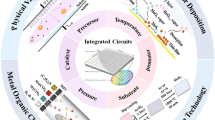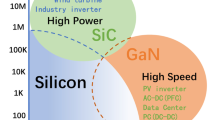Abstract
Recently, three-dimensional (3D) integration technology has been actively pursued as an alternative solution to overcome the significant issues such as the increase in resistance capacitance (RC) delay and power consumption in fabricating two-dimensional complementary metal oxide semiconductor field emission transistor of less than 10 nm node. To integrate the 3D structure of a transistor cell, a high Ge-film polishing rate is required to polish the facet crystalline Ge while fabricating the Ge channel or germanium on insulator (GOI) substrate through recrystallization and epitaxial growth processes in the sequential 3D integration technology. The analysis of the chemical composition of the Ge surface and Ge-film CMP in the neutral and alkaline regions from pH 7 to 11 using a slurry containing colloidal silica abrasive and H2O2 revealed that the formation of oxidation layer (GeO and GeO2) in the polished Ge-film surface linearly increased when the pH of the slurry was between 7 and 10 and slightly decreased when it was higher than 10. These results indicate that the main CMP mechanism is based on the formation of GeO and GeO2 owing to the oxidation reaction between dissolved oxygen and the Ge-film surface in the neutral and alkaline pH regions, rather than the dissolution mechanism associated with the Ge-film CMP mechanism. Significantly, a very high Ge-film polishing rate of 623.9 nm/min was achieved at a pH of 10, at which maximum number of layers of GeO and GeO2 were formed on the Ge-film surface.





Similar content being viewed by others
Data availability
Data can be available upon request from the authors.
References
Garidis, K. Applications of Si1−xGex Alloys for Ge Devices and Monolithic 3D Integration, (2020)
IRDS systems and architectures team international roadmap for devices and systems: executive summary. IEEE Adv. Technol. Humanit, 63 (2020).
Mistry, K. et al. Introducing 14-Nm FinFET technology in microwind to cite this version : HAL Id : Hal-01541171 introducing 14-Nm FinFET technology in microwind. Proc. 49th Des. Autom. Conf. - DAC ’12, 37 637371 (2017).
Guo, D. et al. FINFET technology featuring high mobility SiGe channel for 10nm and beyond. Dig. Tech. Pap. - Symp. VLSI Technol., 2016-Septe (2016), doi:https://doi.org/10.1109/VLSIT.2016.7573360.
A. Razavieh et al., Challenges and limitations of CMOS scaling for FinFET and beyond architectures. IEEE Trans. Nanotechnol. 18, 999–1004 (2019). https://doi.org/10.1109/TNANO.2019.2942456
IRDS Systems and Architectures Team International Roadmap for Devices and Systems: Beyond CMOS 2021 EDITION, (2021)
Batude, P. et al. 3D Sequential Integration: Application-Driven Technological Achievements and Guidelines. Tech. Dig. - Int. Electron Devices Meet. IEDM, 3.1.1–3.1.4 (2018), doi:https://doi.org/10.1109/IEDM.2017.8268316.
Batude, P. et al. Advances, Challenges and Opportunities in 3D CMOS Sequential Integration. Tech. Dig. - Int. Electron Devices Meet. IEDM, 151–154 (2011), doi:https://doi.org/10.1109/IEDM.2011.6131506.
Mallik, A. et al. The impact of sequential-3D integration on semiconductor scaling roadmap. Tech. Dig. - Int. Electron Devices Meet. IEDM, 32.1.1–32.1.4 (2018), doi:https://doi.org/10.1109/IEDM.2017.8268483.
Musavvir, S. et al. Inter-Tier Process Variation-Aware Monolithic 3D NoC Architectures. arXiv. (2019)
Abedin, A. Germanium Layer Transfer and Device Fabrication for Monolithic 3D Integration
Brunet, L. et al. Breakthroughs in 3D Sequential Technology. 153–156 (2018)
P. Batude et al., 3-D Sequential integration: a key enabling technology for heterogeneous co-integration of new function with CMOS. IEEE. J. Emerg. Sel. Top. Circuits Syst. 2, 714–722 (2012). https://doi.org/10.1109/JETCAS.2012.2223593
A. Abedin et al., Germanium on insulator fabrication for monolithic 3-D integration. IEEE J. Electron Devices Soc. 6, 588–593 (2018). https://doi.org/10.1109/JEDS.2018.2801335
Claeys, C., Simoen, E. Challenges for Advanced End of the Roadmap, beyond Si and beyond CMOS Technologies. SBMicro 2017 - 32nd Symp. Microelectron. Technol. Devices Chip Sands, co-located Symp. 30th SBCCI - Circuits Syst. Des. 2nd INSCIT - Electron. Instrumentation, 7th WCAS - IC Des. Cases 17th SForum - Undergrad. (2017), doi:https://doi.org/10.1109/SBMicro.2017.8112970.
N. Wu et al., A TaN – HfO 2 – Ge PMOSFET with novel. IEEE Electron Device Lett. 25, 631–633 (2004)
Mitard, J. et al. Record Ion/Ioff Performance for 65nm Ge PMOSFET and Novel Si Passivation Scheme for Improved EOT Scalability. Tech. Dig. - Int. Electron Devices Meet. IEDM, 2–5 (2008) doi:https://doi.org/10.1109/IEDM.2008.4796837
Liu, Y. et al. Strained Ge 0.96 Sn 0.04 P-Channel MOSFETs With In Situ Low Temperature Si2H6 Surface Passivation. 7th International Silicon-Germanium Technology and Device Meeting (ISTDM), 3 107–108 (2014)
B. Vincent et al., Si passivation for Ge PMOSFETs: impact of Si cap growth conditions. Solid. State. Electron. 60, 116–121 (2011). https://doi.org/10.1016/j.sse.2011.01.049
X. Ou, A. Keller, M. Helm, J. Fassbender, S. Facsko, Reverse epitaxy of Ge: ordered and faceted surface patterns. Phys. Rev. Lett. 111, 1–5 (2013). https://doi.org/10.1103/PhysRevLett.111.016101
G. Wang et al., Selective epitaxial growth of germanium on si wafers with shallow trench isolation: an approach for Ge virtual substrates. ECS Trans. 16, 829–836 (2008). https://doi.org/10.1149/1.2986842
F. Iwawaki, M. Tomitori, O. Nishikawa, STM study of epitaxial growth of Ge on Si(001). Surf. Sci. Lett. (1991). https://doi.org/10.1016/0167-2584(91)90369-3
S. Peddeti, P. Ong, L.H.A. Leunissen, S.V. Babu, Chemical mechanical polishing of Ge using colloidal silica particles and H2O2. Electrochem. Solid State Lett. (2011). https://doi.org/10.1149/1.3575166
N. Cerniglia, P. Wang, Dissolution of germanium in aqueous hydrogen peroxide solution. J. Electrochem. Soc. 109, 508 (1962). https://doi.org/10.1149/1.2425457
Q. Chen, J. Li, Y.A. Li, Review of plasma-liquid interactions for nanomaterial synthesis. J. Phys. D. Appl. Phys. (2015). https://doi.org/10.1088/0022-3727/48/42/424005
I.M. Huygens, W.P. Gomes, K. Strubbe, Etching of germanium in hydrogenperoxide solutions. ECS Meet. Abstr. MA200-01, 616–616 (2007). https://doi.org/10.1149/ma2007-01/13/616
J.B. Matovu, N.K. Penta, S. Peddeti, S.V. Babu, Chemical mechanical polishing of Ge in hydrogen peroxide-based silica slurries: role of ionic strength. J. Electrochem. Soc. 158, H1152 (2011). https://doi.org/10.1149/2.055111jes
A. Gupta, R. Manivannan, S.N. Victoria, Effect of potassium periodate oxidizer on germanium chemical mechanical planarization using fumed silica as abrasive. ECS J. Solid State Sci. Technol. 8, P3085–P3090 (2019). https://doi.org/10.1149/2.0151905jss
E.B. Seo, J.G. Park, J.Y. Bae, J.H. Park, Highly selective polishing rate between a tungsten film and a silicon-dioxide film by using a malic-acid selectivity agent in tungsten-film chemical-mechanical planarization. J. Korean Phys. Soc. 76, 1127–1132 (2020). https://doi.org/10.3938/jkps.76.1127
Y.H. Son, J.G. Park, B.K. Choo, S. Kang, bae self-stopping slurry for planarizing extremely high surface film topography in nanoscale semiconductor devices. J. Korean Phys. Soc. 79, 44–48 (2021). https://doi.org/10.1007/s40042-021-00207-x
S.S. Yun, J.G. Park, Impact of wet ceria abrasive size on initial step height removal efficiency for isolated SiO2 film chemical mechanical planarization. J. Korean Phys. Soc. 78, 51–57 (2021). https://doi.org/10.1007/s40042-020-00022-w
Acknowledgements
This research was supported by the Republic of Korea’s MOTIE(Ministry of Trade, Industry & Energy (NTIS 1415173045) and KSRC(Korea Semiconductor Research Consortium) (20010752) support program for the development of the future semiconductor device, by the Brain Korea 21 PLUS Program.
Author information
Authors and Affiliations
Corresponding author
Ethics declarations
Conflict of interest
The authors declare that they have no conflict of interest.
Additional information
Publisher's Note
Springer Nature remains neutral with regard to jurisdictional claims in published maps and institutional affiliations.
Supplementary Information
Below is the link to the electronic supplementary material.
Rights and permissions
Springer Nature or its licensor (e.g. a society or other partner) holds exclusive rights to this article under a publishing agreement with the author(s) or other rightsholder(s); author self-archiving of the accepted manuscript version of this article is solely governed by the terms of such publishing agreement and applicable law.
About this article
Cite this article
Bae, JY., Han, MH., Shim, TH. et al. Chemical mechanical planarization mechanism of epitaxially grown Ge-film for sequential integrating 3D-structured transistor cells. J. Korean Phys. Soc. 81, 1262–1268 (2022). https://doi.org/10.1007/s40042-022-00662-0
Received:
Revised:
Accepted:
Published:
Issue Date:
DOI: https://doi.org/10.1007/s40042-022-00662-0




